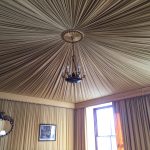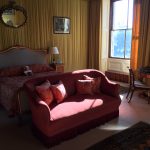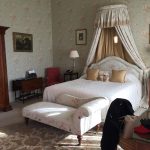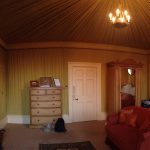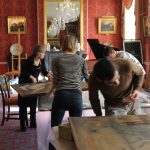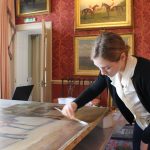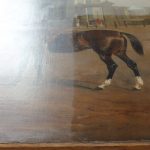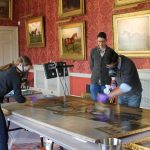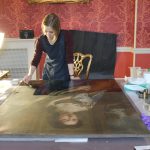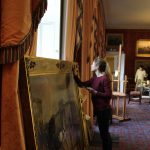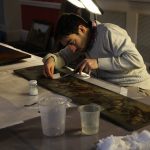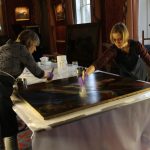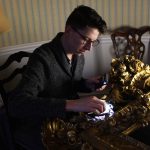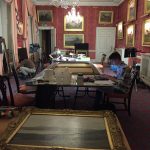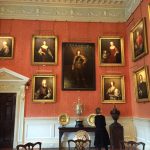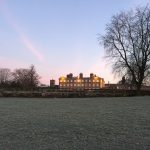
Weston Park is a 17th century manor house owned by the Weston Park Foundation. It has been the seat of the Earls of Bradford since the 17th Century. The house is now open to the public for visits and guided tours in addition to offering venue for conferences, weddings and other events. The collection at Weston Park includes beautiful pieces of furniture, ceramics, tapestries and an impressive collection of paintings that hang in every room, including works by Van Dyck, Holbein the Younger, Thomas Gainsborough, Sir Joshua Reynolds and George Stubbs. For 20 years, these paintings have been the subject of annual in-situ visits by the Hamilton Kerr Institute, which has mainly focused on remedial, preventive and simple aesthetic treatments. This week usually takes place during the Manor’s off-peak season, allowing the conservators, including students and interns, to stay on site during this time in the highest of style!
In February 2016, senior conservator Mary Kempski headed up a team of four interns, Kari Rayner, Sarah Bayliss, Carlos Gonzalez Juste and Sven van Dorst, for the Weston Park in-situ. The work was carried out in the Music Room, a long, spacious room decorated mainly with paintings of the family’s champion horses. Over the week, we treated 16 paintings and their frames performing such tasks as surface cleaning, consolidation, revarnishing and conservation framing.

As with most in-situ projects, some of the paintings worked on would have benefitted from more interventive treatments, such as varnish and overpaint removal. However, as time, space and resources are limiting factors with regard to in-situ work, stabilising the paintings and improving their framing was of primary importance. However, there are several ways to improve a painting’s aesthetic in close confines; surface cleaning drastically improved the visibility in a number of paintings, and as varnishes often become less saturating over time, revarnishing as needed with a stable synthetic varnish such as RegalrezTM was an excellent way of restoring some of the saturation and depth to paintings. This can also help with evening the overall gloss, particularly when previous restorations have aged and become matter over time.
Another important part of the work as part of this in-situ project was to improve the framing of paintings. In the past many paintings were held in the frame by nails, which often damages the stretcher and tacking margins and make the painting difficult to safely remove. Framing can be improved by lining the frame with paper tape and felt, so that the paint surface has a cushion to rest against rather than wood of the frame. Fixings are replaced by brass plates that are screwed in, allowing paintings to be easily removed from the frame in the future. Stretcher keys can sometimes become loose and fall down in between the canvas and stretcher, resulting in damages to the canvas and paint layers: this can be prevented by tying the keys to the stretcher. A Tyvek® backing was added to the reverse of all of the frames to cover the backs of the paintings. This acts as a barrier, protecting the back of the painting from knocks, water damage and the ingress of dirt.
Documentation is also important part of an in-situ visit, as unframing paintings allows them to be properly evaluated for condition and potential issues that might cause problems in the future. Flaking paint and the weakening of the painting’s structural support (for example, the tearing of canvases or splits in wooden panels) are issues which can often be addressed in-situ, but may require further or more elaborate treatment in the studio. This condition checking of paintings is an important part of collection care, and can nip problems in the bud and prevent greater damage to the paintings from neglect.
During our in-situ at Weston Park, there were several opportunities for us to interact with the public and spread the word of conservation! This primarily took the form of ‘conservation in action’ tours, in which people were bought in to see what we were up to. This allowed individuals to directly ask us questions about the treatments of the painting, and also more generally about what we do as conservators. In addition to these tours, we were hounded by the Shropshire press. Mary Kempski and Sarah Bayliss appeared on the local radio talking about painting conservation, the Hamilton Kerr Institute and the in-situ project at Weston Park. The following day, reporters from the Shropshire Star interviewed Mary and took photographs of us in action.
It was refreshing for us to see the staff at Weston Park taking an interest in our work and to have facilitated our engagement with the local community, and we hope by sharing our experiences through this forum to equally engage a wider audience with our profession.
Sarah Bayliss – 1st year Post Graduate Intern at the Hamilton Kerr Institute
About the author
Ms Sarah Bayliss is a graduate of the Post-graduate Diploma in the Conservation of Easel Paintings at The Courtauld Institute in London. She also has a Master of Chemistry from the University of East Anglia in Norwich, UK.
To contact Sarah Bayliss: sarahebayliss@gmail.com

